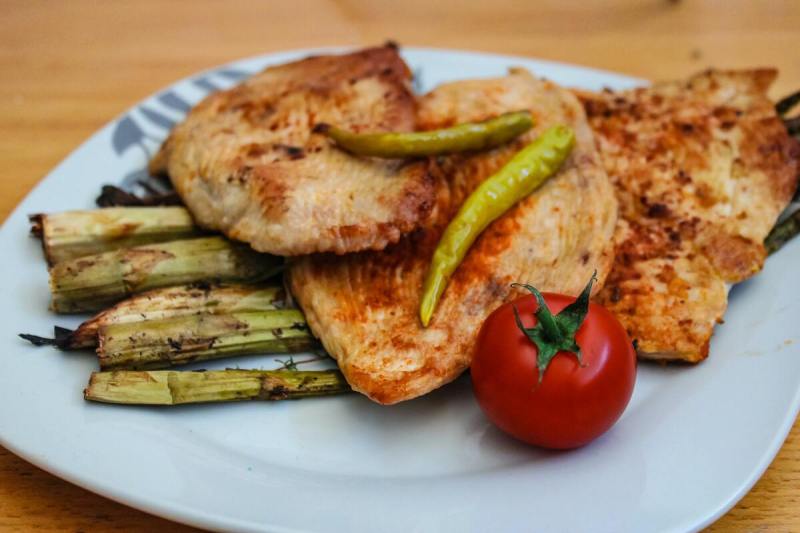With protein being one of the three macronutrients needed for energy and physiological processes, you’re probably trying to figure out the best way to get enough in your diet. Naturally, you’ve heard of many popular diets and fad trends, but it’s best to start with a tried-and-true, high-quality protein source like chicken.
Take it a step further and explore the cut of meat and the versatility of your chicken. Learning how much protein is in a chicken breast or how much fat is in chicken thighs can shape your meal planning throughout the week. As you pursue adequate protein for muscle building and health benefits, keep your eye on the different parts of the chicken, how to execute your meal prep, and the perfect way to sustain your plans.
How much protein is in each part of the chicken?

Breast
A chicken breast contains 32 grams of protein per 100 grams. This cut has the most protein by weight and the fewest calories, so it’s ideal for weight loss diets and sustaining muscle mass. As the leanest piece, it is the best selection for improving recovery and maintaining muscle mass, and it’s a popular choice among bodybuilders.
Drumstick
Drumsticks contain 24 grams of protein per 100 grams and have more fat than chicken breasts. The larger calorie content makes this a good cut for gaining weight.
Thigh
The chicken thigh has about 25 grams of protein per 100-gram serving. The thigh and drumstick make up the leg and have higher fat content than the breast. The thigh is one of the pieces you’d eat if you’re following a low-carb or ketogenic diet.
Wing
Like the drumstick, chicken wings contain 24 grams of protein per 100 grams. However, this part of the chicken is the most calorically dense, with roughly 254 calories in a 100-gram serving, which is greater than the other cuts discussed, each consisting of fewer than 180 calories per 100-gram serving.
How much protein should you eat daily?

Individual needs often dictate daily protein intake. The current recommended dietary allowance for adults is 0.8 to 1 gram per kilogram of body weight. However, some needs may be higher or lower, with additional consideration to special needs, inactivity, specific wound care, or kidney health.
For the average adult, this is roughly 50 grams of protein intake daily. However, if you regularly exercise, then you want to eat more like 1.8 to 2 grams per kilogram of body weight. You can boost your protein intake daily through sources like protein shakes, Greek yogurt, lean meats, and plant sources like chickpeas and beans.
Is chicken a good protein option?

Chicken is a classic whole food to start with when increasing dietary protein sources. It is a lean meat that provides adequate protein and supplies necessary nutrients like iron and zinc. It’ll be wise to include lean meat like chicken in your diet because it encourages muscle growth and strength, promotes good cardiovascular health, and helps modulate weight management.
Chicken is among the most discussed and consumed animal protein sources because it contains all nine essential amino acids. These are nine amino acids needed to make proteins and stimulate tissue repair and muscle growth, but they aren’t made in the body, so they must be provided via the diet. Some foods that contain some but not all are considered incomplete proteins, but chicken contains all nine and is considered a complete source.
Overall chicken breast nutrition facts

Chicken breast is an excellent choice for boosting your dietary protein, as it has high nutritional value. There are more than 30 grams of protein in a 100-gram serving of chicken breast, which is almost a 4-ounce serving. The breast is also a low-fat choice, as the chicken breast contains less than 1 gram of fat. You’ll also find calcium, iron, and sodium to be other notable components.
How to include chicken in your diet

Try different preparation techniques
Use various preparation methods, like grilling or roasting, to keep your chicken versatile. Try cooking without the skin as well, and explore boneless chicken recipes. You could also try baked chicken wings or steamed drumsticks with roasted vegetables dressed with various herbs and seasonings.
Chicken for breakfast
Don’t limit yourself to having chicken for just lunch or dinner. It can also be a significant part of breakfast. Grab a mix of spinach, bell peppers, and other veggies, and put your chicken inside a breakfast taco or burrito. Expand your options beyond chicken and waffles; slice your chicken breast into a breakfast skillet with sausage, bacon, and eggs.
Explore new recipes
Chicken doesn’t always have to be the star but can serve as an excellent meal complement. Look for chicken
Versatile
Frequently asked questions

Is two chicken breasts a day enough protein?
On average, two chicken breasts daily may be sufficient protein intake. A 4-ounce serving of chicken breast contains 26 grams of protein, so with two servings, you could surpass the minimum recommendation of 50 grams.
How much protein is in 6 ounces of cooked chicken breast?
A 6-ounce cooked chicken breast is approximately 170 grams, containing about 50 grams of protein. A portion of 174 grams of chicken breast contains nearly 56 grams of protein. Within a 200-gram serving of chicken breast, there are 62 grams of protein.
How much protein do you need a day to build muscle?
Based on endurance activities, you’ll need somewhere between 1.2 and 2 grams of protein to build muscle. These needs may be due to the intensity and duration of the activities. It’s important to know that you don’t have to go overboard with protein consumption when you want to build muscle. It’s still vital to have a balanced diet consisting of carbs and healthy fats.




